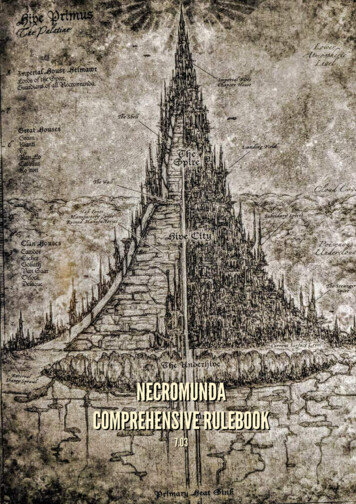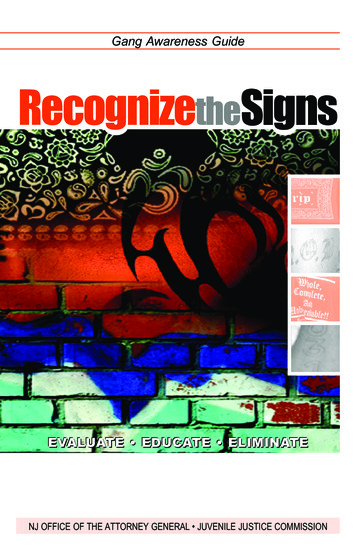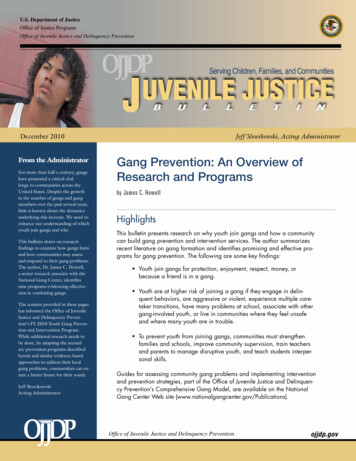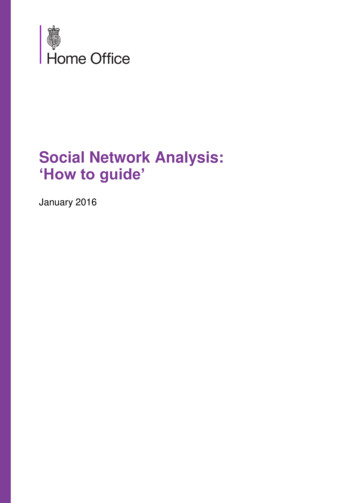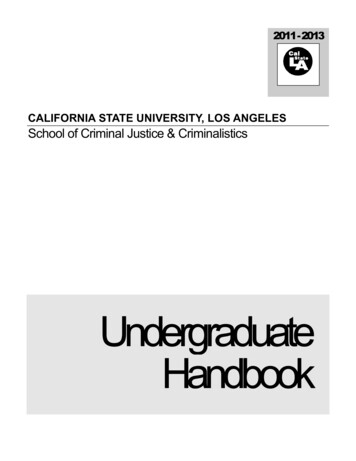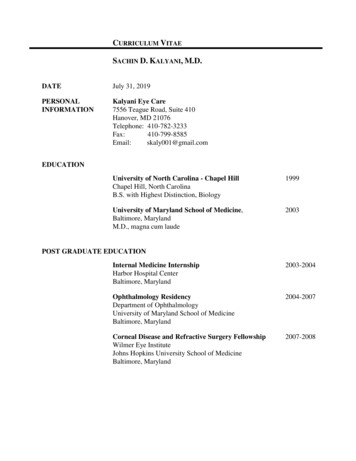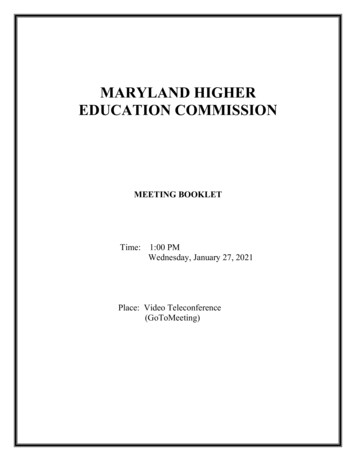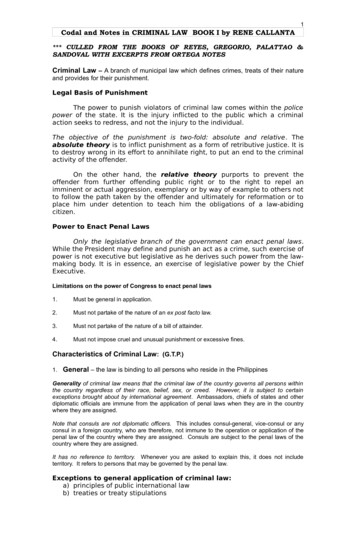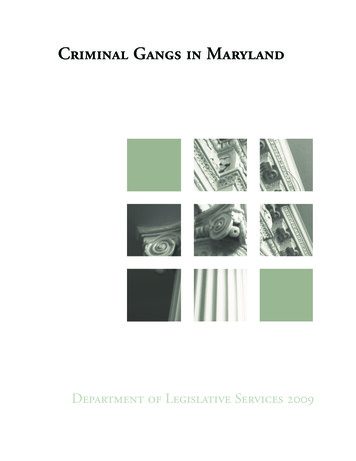
Transcription
Criminal Gangs in MarylandDepartment of Legislative Services 2009
Criminal Gangs in MarylandDepartment of Legislative ServicesOffice of Policy AnalysisAnnapolis, MarylandJanuary 2009
For further information concerning this document contact:Library and Information ServicesOffice of Policy AnalysisDepartment of Legislative Services90 State CircleAnnapolis, Maryland 21401Baltimore Area: 410-946-5400 Washington Area: 301-970-5400Other Areas: 1-800-492-7122, Extension 5400TDD: 410-946-5401 301-970-5401Maryland Relay Service: 1-800-735-2258E-mail: libr@mlis.state.md.usHome Page: http://mlis.state.md.usThe Department of Legislative Services does not discriminate on the basis of race, color, nationalorigin, sex, religion, or disability in the admission or access to its programs or activities. Thedepartment’s Information Officer has been designated to coordinate compliance with thenondiscrimination requirements contained in Section 35.107 of the Department of Justiceregulations. Requests for assistance should be directed to the Information Officer at thetelephone numbers shown above.ii
January 9, 2009The Honorable Thomas V. Mike Miller, Jr., President of the SenateThe Honorable Michael E. Busch, Speaker of the HouseMembers of the Maryland General AssemblyLadies and Gentlemen:This report, Criminal Gangs in Maryland, was prepared by the Department of LegislativeServices, Office of Policy Analysis, in response to the continuing legislative interest on the issueof gangs in the State and region. The report discusses proposals by the Office of AttorneyGeneral and the Maryland State Attorneys’ Association for changes in the law, a history andstatus report of the gang problem in Maryland provided by the Maryland State Police, and thelatest statistics from various counties within the State.This report was written by John J. Joyce and Jennifer Botts under the editorial directionof Douglas R. Nestor.I trust this information will be of assistance to you.Sincerely,Warren G. DeschenauxDirectorWGD/JJJ/lkjiii
iv
ContentsTransmittal Letter. iiiIntroduction.1Maryland Gang Activity .1History.1Current Status.2Prison Gangs .3Report by the Attorney General and the Maryland State Attorneys’ Association.4Proposals(1)Expand Definition of “Gang” .4(2)Adding Misdemeanors as Underlying Crimes in Gang Prosecution .4(3)Require Consecutive Sentencing .5(4)Gang Activity – Nuisance Abatement by Property Owners .5(5)Juveniles – Prosecution as Adults.6(6)Forfeiture of Property and Proceeds .6(7)Identifiers for Gang Membership.6(8)Permanent Gang Task Force.7Appendix: Gang Statistics.9Anne Arundel County .9Baltimore City.10Baltimore County.11Harford County .11Howard County.12Montgomery County.13v
vi
Criminal Gangs in MarylandIntroductionThis report provides an analysis of the most recent developments on the issue of gangs inMaryland, including a history and status report of the gang problem in Maryland, a discussion ofprison gangs, proposals by the Office of the Attorney General and the Maryland State Attorneys’Association for changes in the law, and recent statistics from various counties within the State.Maryland Gang ActivityHistoryThe Maryland State Police has provided the Department of LegislativeServices with a history of the emergence of gangs in Maryland. Using an analytical method thatthe Maryland State Police describes as “semi-chronological and geographical” and concedingthat the information it contains is a “combination of both anecdotal and validated intelligence,”the history warns that the arrival of nationally known gangs has “led to a surge of gang activitythroughout the State.” The following history of gangs in Maryland is based on the informationprovided by the Maryland State Police.Until the turn of the 21st century, most gangs were concentrated in, but not limited to,Baltimore City or Washington, DC. The gangs were small organizations that generally ruledstreet corners or neighborhoods. The gangs traditionally concentrated on one form of criminalenterprise (e.g., distribution of a specific drug, auto theft, etc.) and did not compete with oneanother.In the late 1990s, members of the Bloods gang started coming south into Baltimore fromNew York and New Jersey. By 1999, the founder of the Bloods gang had expanded operationsinto Baltimore, Hagerstown, and Frederick. One of the first things the Bloods did in Baltimorewas to unite several gangs along the Edmondson Avenue corridor into one Bloods subset. TheBloods also began an aggressive recruiting drive within Maryland’s prison population. Gangmembers started requesting Hagerstown release addresses, and the Bloods became established inWestern Maryland.From 2000 to 2002, the Bloods grew steadily throughout the Baltimore region. Smallsets began sprouting in Baltimore City, Baltimore County, and Harford County. Individualmembers, recruited in prison, were being released into Maryland communities. For the nextseveral years, the Bloods began to spread across the State, with specific subsets emerging indifferent counties. Established neighborhood gangs began to “blood over,” or align underneath1
2Department of Legislative Servicesthe umbrella of the Bloods. This was partially in response to the expanding threat posed by rivalgangs, specifically MS-13. The past several years have seen an increase in fighting within thegang (subsets associated with east coast Bloods fighting with west coast Bloods).As this was occurring in the Baltimore region, the population of immigrants fromEl Salvador and other Latin American countries increased in Washington, DC. Incidental to thisincrease was the introduction of MS-13 to the Washington, DC suburbs. When the gangoriginated, it was comprised entirely of Salvadorians, but eventually it fell under the umbrella ofthe Mexican Mafia. In the 1990s, MS-13 gang members had spread to the Washington, DC areabut were mostly concentrated in northern Virginia. By 2000, law enforcement had indentifiedthree to five subsets of the gang in Montgomery County. MS-13 was largely confined to SilverSpring and Wheaton in Montgomery County and the Langley Park area of Prince George’sCounty.Between 2003 and 2005, MS-13 spread across the State, with approximately 25 cliquesactive or present in Maryland by 2005. The gang’s aggressive tactics and recruiting led to anincrease in membership and an increase in the number of rival gangs. MS-13’s approach to theserival gangs involved numerous homicides, assaults, and rapes, which led eventually to itstargeting by law enforcement.According to the Maryland State Police, MS-13 has been relatively quiet since 2006.Intelligence suggests that gang members are instructed to refrain from getting gang-relatedtattoos and wearing gang clothing. They continue to have members and cliques throughout theState but are still concentrated in Langley Park and Silver Spring. The gang is continuing tomake money through narcotics, extortion, and prostitution, among other criminal activities.Current StatusThe expansion of nationally known gangs in Maryland continues to pose challenges tocommunities and to law enforcement. Youths start neighborhood gangs to defend themselvesfrom these larger national gangs and larger gangs attempt to absorb these smaller, neighborhoodgangs.In response to the gang problem, the “Kaizen Project” was established byGovernor Martin O’Malley. The mission of the project is to “develop statewide strategies forMaryland’s criminal justice and non-criminal justice organizations” and to “proactively curb theinfluence of gangs collectively and holistically.” Leaders from 5 entities (the Maryland StatePolice, the Baltimore City Police Department, the Baltimore County Police Department, theDepartment of Juvenile Services, and the Department of Public Safety and CorrectionalServices) determine the direction of the project, but over 50 criminal justice stakeholders areinvolved in the project.The Maryland State Police reports the presence of gangs in 22 counties (all but Somersetand Worcester). The most prominent gangs identified by the State Police are the Bloods (presentin 20 counties), the Crips (present in 9 counties), and MS-13 (present in 10 counties). In all but 2
Criminal Gangs in Maryland3counties where the Bloods are reported, there are at least 2 subsets of the gangs, with BaltimoreCity alone having 18 subsets. The Crips gangs have subsets in 8 of the counties in which theyare reported to have members. Subsets of MS-13 are reported in Montgomery and PrinceGeorge’s County, with 6 and 12 subsets respectively. Other gangs with membership in at least2 counties are: Vatos Locos (3 counties), Dead Men Incorporated (5 counties), SUR-13(7 counties), Latin Kings (2 counties), and 18th Street (2 counties).Prison GangsThe State’s prison gang situation resembles that of the street gang population in manyrespects. However, the prison system is a more static and controlled environment andconsequently standardization and identification of gang members is somewhat more refined.The Department of Public Safety and Correctional Services designates gangs as Security ThreatGroups (STG) and defines them as “three or more individuals who possess a common distinctivegoal, symbolism, or philosophy; pose a present or potential threat to the safety of staff, inmates,or the public; and possess identifiable skills or resources used to engage in unauthorized orcriminal activities either within the prison system or in the community.”Prison gang data are gathered by both gang intelligence and correctional officers in avariety of ways. Initial identification of an inmate as a gang member may occur on intake at theMaryland Reception, Diagnostic, and Classification Center through the use of a validationworksheet point system in which an individual is assessed points based on having or displayinggang paraphernalia, tattoos, signs, colors, or symbols; a previous identification as a gang memberor association with known gang members; being named by another individual as being a gangmember; or an admission of gang membership from the inmate. An inmate who receives at least2 to 9 points is considered an “associate” of a gang and an inmate with 10 or more points isconsidered a “validated” member. An inmate who is validated as a gang member remains on thedepartment’s list permanently, regardless of whether the inmate denounces the gang, changesaffiliation, or is released.As of August 2008, through the use of the validation point system, the department hasidentified 2,937 STG participants, of which 2,423 are validated gang members and 514 areassociate inmates. The department advises that it reevaluates members constantly, and the vastmajority of individuals currently designated as “associate inmates” are eventually validated asgang members.According to the department, the identified STG members participate in 260 differentgangs that exist within the prison system, including historic prison gangs, neighborhood streetgangs, nationally recognized gangs, and drug gangs. According to the department, the mostprevalent STGs currently are the Bloods, Crips, Black Guerilla Family, Dead Man Inc., andMurder Inc. The department also reports that gang activity appears to be present in BaltimoreCity and every county.
4Department of Legislative ServicesReport by the Attorney General and the Maryland State Attorneys’AssociationConcern about reports of increased gang activity led to the enactment of the MarylandGang Prosecution Act of 2007 (Chapter 496) which created separate offenses relating to criminalgangs and authorized the Attorney General to aid in investigations and prosecutions at therequest of a State’s Attorney for a county. Chapter 496 prohibits a person from (1) participatingin a criminal gang knowing that the members of the gang engage in an ongoing pattern ofcriminal gang activity; or (2) knowingly or willfully directing or participating in the commissionof an underlying crime, or act by a juvenile that would be an underlying crime if committed byan adult, committed for the benefit of, at the direction of, or in association with a criminal gang.A violator is guilty of a felony and subject to imprisonment not exceeding 10 years, or 20 yearsif death to a victim occurs, and/or a fine not exceeding 100,000.The Act also required the Attorney General and the Maryland State Attorneys’Association to report to the General Assembly on their recommendations for more legislation toassist in the prosecution of gang activity. The report was submitted on January 1, 2008. CallingChapter 496 an “historic first step” in the State’s battle against gang activity, the report went onto criticize the statute as “falling short in a number of respects.” The report offers eightproposals for additional legislation to aid in the prosecution of gang activity. The followingrelates and evaluates these proposals:(1)Expand Definition of “Gang”The report contends that defining a criminal gang as an “ongoing association” is“confusing” and “may leave open for argument” that the alleged gang must be “ongoing” “evenat the time of arrest or trial.” Although the report anticipates a potential problem with provingthis element of a gang offense, it cites no court case in Maryland or elsewhere in which aconviction was not obtained because of a failure to prove this element. In fact, the use of“ongoing” or “ongoing association” can be found in the definitional language for gangs in atleast 20 other jurisdictions (Arizona, California, Colorado, Delaware, Florida, Idaho, Iowa,Louisiana, Minnesota, Missouri, Montana, New York, North Dakota, Ohio, Oklahoma, SouthDakota, Tennessee, Virginia, Washington, and Wisconsin). In addition, several other states useclosely synonymous terminology like “continuously or regularly associating” (Texas),“continuing series” (Arkansas), or “so constructed that will continue” (Nevada).(2)Adding Misdemeanors as Underlying Crimes in Gang ProsecutionMaryland law currently restricts the underlying crime committed for the benefit of, at thedirection of, or in association with a criminal gang that is needed to prove a gang violation tocrimes of violence and felony violations of certain laws. The report argues (although noevidence is cited) that there are various other crimes that are “well understood” to be closelyassociated with gang activity, but which are classified as misdemeanors. The report suggests that
Criminal Gangs in Maryland5the list of underlying crimes be expanded to include the misdemeanor crimes of maliciousdestruction of property (e.g., graffiti), pandering, second degree assault, receiving earnings of aprostitute, and wagering. Such a change would undoubtedly make the gang law easier to use byprosecutors. It would raise the possibility, however, that one could be convicted of the felony ofgang participation by being associated with a gang that can only be shown to have engaged inmisdemeanors.(3)Require Consecutive SentencingThe report argues that the impact of Chapter 496 is “substantially diminished” because,as currently written, a court may order a sentence for a gang violation to run concurrently withthe sentence for the underlying crime. The proposal would require that, where imposed, the gangoffense be served consecutively to the sentence for the underlying crime. The report points outthat it does “not propose to make a [sentence for a] separate gang specific offense mandatory, asthe trial judge retains the right to suspend any portion of either sentence.” Mandating that suchsentences run consecutively would place Maryland with eight other jurisdictions that havesimilarly limited the discretion of the sentencing judge (California, Georgia, Idaho, Indiana,Louisiana, Missouri, Montana, and Nevada).(4)Gang Activity – Nuisance Abatement by Property OwnersThe report proposes that Senate Bill 631 of 2007, which would allow a prosecutor to holda property owner responsible if the owner allows gang members to meet on or use the propertyfor gang-related criminal activity, be reintroduced and enacted. Fifteen other jurisdictions(Arkansas, California, Colorado, Florida, Georgia, Iowa, Louisiana, Mississippi, Missouri, NewMexico, Ohio, Texas, Virginia, Washington, and Wisconsin) have statutes that enable the civilprosecution of the owner of real property for maintaining a public nuisance if the ownerknowingly harbors gang activity on the property. The 2007 bill received support from theMaryland Chiefs of Police Association, the Maryland Sheriffs’ Association, and Maryland LawEnforcement Officers, Inc. as an “additional tool” to combat gangs.The 2007 bill was opposed, however, by the Greater Baltimore Board of Realtors(GBBR) and the Office of Public Defender. The GBBR argued that the bill would create an“unnecessarily broad exposure to possible termination actions of both commercial and residentialleases and ownership rights.” Specifically, the GBBR expressed concern that such legislationcould cause the rights of both tenants and property owners to be unfairly terminated in instanceswhere nuisance activity occurs on property “despite reasonable efforts by either the tenant orproperty owner to abate the nuisance.” The Office of Public Defender argued that the bill was“unconstitutional on its face” in that it violated the First Amendment right of association and was“impermissibly vague” in that it failed to establish standards for the police and public that weresufficient “to guard against the arbitrary deprivation of liberty.”
6Department of Legislative ServicesA similar bill that was introduced in the 2008 session, Senate Bill 635, received supportfrom the Apartment and Office Building Association of Metropolitan Washington and theMaryland Association of Realtors (MAR). MAR stated that the bill provided “an appropriatebalance between individual rights and the right of a community to take action against seriouscriminal
Jan 09, 2009 · The Maryland State Police reports the presence of gangs in 22 counties (all but Somerset and Worcester). The most prominent gangs identified by the State Police are the Bloods (present in 20 counties), the Crips (present in 9 co


